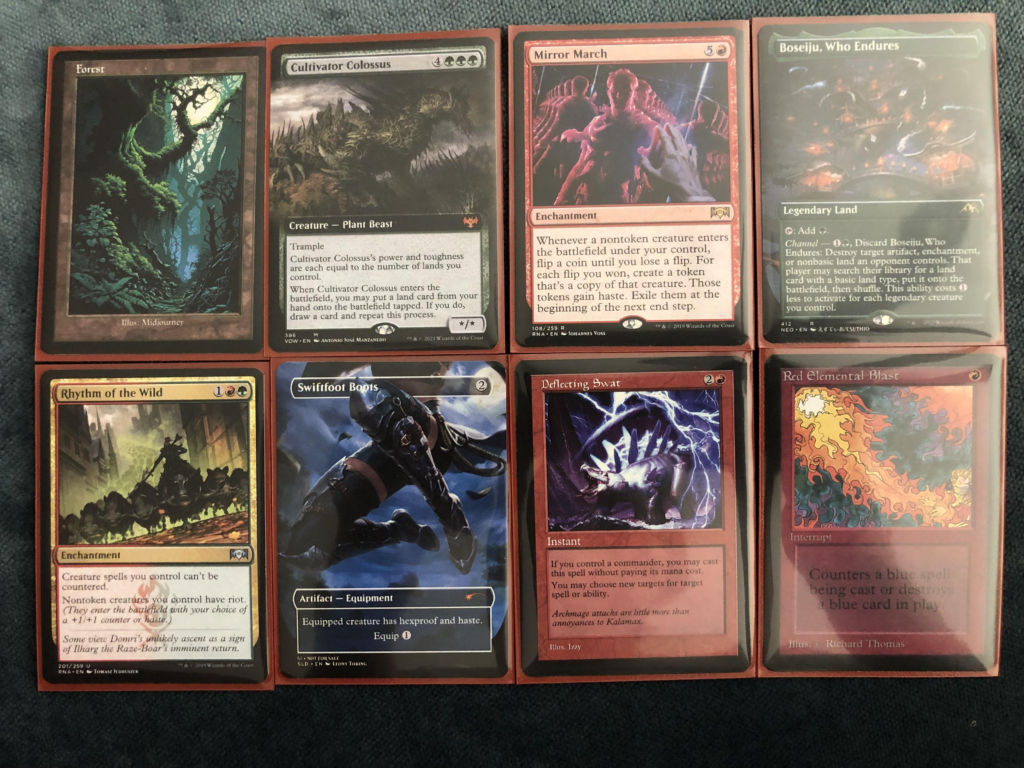Blog
Introduction
Magic: The Gathering (MTG) is a popular collectible card game enjoyed by players around the world. Players often seek ways to improve their deck and game strategy to become more competitive. One way to do this is by using proxies. In this article, we’ll explore what proxies are, why players use them, and the different types of proxies available.

What are proxies in MTG?
Proxies are substitute cards used in place of actual MTG cards. These substitute cards may be hand-drawn, printed, or professionally made. Proxies can represent any card in the game, including rare and expensive ones. Players use proxies for a variety of reasons, including testing new decks, playing in casual settings, and participating in tournaments.
Why do players use proxies?
Players use proxies for several reasons. One reason is to test new decks before investing in expensive cards. Proxies allow players to try out different strategies and card combinations without the cost of purchasing rare or expensive cards. Proxies also provide players with the ability to play with cards that are no longer in print or have been banned from competitive play. MTG Proxies can be an affordable way for players to experience the full range of the game without breaking the bank.
The Legality of Proxies in MTG
One of the biggest questions players have about proxies in MTG is whether or not they are legal. The answer to this question is somewhat complicated, as it depends on the context in which the proxies are being used. In general, proxies are not legal in sanctioned MTG tournaments. This means that if you plan on competing in an official tournament, you cannot use proxies in your deck. The reason for this is that sanctioned tournaments are meant to be a test of a player’s skill and knowledge of the game, and allowing MTG Proxieswould give some players an unfair advantage. However, proxies are allowed in casual play, and many players use them in this context. Some players enjoy creating their own MTG Proxiesas a creative outlet, while others use them to test out new decks or strategies before investing in the real cards. As long as everyone playing in a casual game is aware of proxies MTG that are being used and agrees to it, there is no harm in using them.
Types of Proxies in MTG
When it comes to proxies in MTG, there are three main types: hand-drawn proxies, printed proxies, and high-quality printed proxies. Each type has its own unique benefits and drawbacks.
- Hand-drawn proxies are the most basic type of proxy. As the name suggests, these proxies MTG are drawn by hand and are often used by players who want to test out new card ideas or play with cards they don’t own. Hand-drawn proxies are easy to make and require only a few basic materials.
- Printed proxies are the most popular type of proxy. They are printed using a printer and special paper that can be easily purchased online. Printed proxies MTG are more durable than hand-drawn proxies and can look quite professional when designed well.
- High-quality printed proxies are the most advanced type of proxy. These proxies are printed on high-quality cardstock using professional equipment, resulting in a finished product that looks and feels almost identical to a real MTG card. High-quality printed proxies are often used by players who want to play with expensive or hard-to-find cards that they don’t want to risk damaging.
How to Make Hand-drawn Proxies
Hand-drawn proxies are the easiest type of proxy to make. Here’s what you’ll need:
Materials needed for hand-drawn proxies MTG:
- A piece of blank paper
- A pen or marker
- An MTG card to use as a reference
Step-by-step guide to making hand-drawn proxies:
- Place the blank piece of paper on top of the MTG card you are using as a reference.
- Trace the outline of the card onto the paper using your pen or marker.
- Fill in the card with the details of the card you want to proxy, including the card’s name, mana cost, text box, power/toughness, and any other relevant information.
- Color the card using your pen or marker.
- And there you have it! Your very own hand-drawn proxy.
How to Make Printed Proxies
Printed proxies are a bit more complicated to make than hand-drawn proxies, but they’re still fairly simple. Here’s what you’ll need:
Materials needed for printed proxies:
- A printer
- Printable proxy paper
- Image editing software (optional)
- An MTG card to use as a reference
Step-by-step guide to making printed proxies:
- Find or create an image of the card you want to proxy. You can find images of almost every MTG card online, or you can create your own using image editing software.
- Print the image onto the printable proxy paper. Be sure to follow the manufacturer’s instructions for printing on the paper.
- Cut out the printed proxy card.
- Glue the printed MTG proxy cards onto a basic land card or another card that you don’t need. This will give your proxy some weight and make it easier to shuffle with your other cards.
Where to find pre-made printed proxies online?
If you don’t want to make your own proxies, there are many websites that sell pre-made printed proxies. Some popular sites include mtgproxy.com, Printingproxies.com, and cardmire.com. Keep in mind that these sites may not be legal, and using their proxies could get you in trouble with Wizards of the Coast.
How to Make High-quality Printed Proxies
High-quality printed proxies are the most difficult type of proxy to make, but they also look and feel the most like real MTG cards. Here’s what you’ll need:
Materials needed for high-quality printed proxies:
- A professional printer
- High-quality cardstock
- Image editing software
- An MTG card to use as a reference
Using Proxies in MTG Tournaments
Now, let’s talk about using proxies in MTG tournaments. This is where the rules can get a bit stricter. In official Wizards of the Coast-sanctioned events, proxies are not allowed, and using them can result in disqualification. However, some smaller, unsanctioned events may allow proxies, so it’s important to check with the event organizer beforehand. Additionally, some local game stores may host events that allow the use of proxies, but again, it’s important to check the rules beforehand.
If proxies are allowed, there are usually restrictions on the number of proxies that can be used in a deck. For example, some events may allow a maximum of 15 proxies, while others may allow only a few. It’s also important to note that using proxies in tournaments can be controversial. Some players argue that it gives an unfair advantage to those who can afford high-quality proxies, while others argue that it levels the playing field and allows for more diverse and creative deckbuilding.
Tips for using proxies in MTG tournaments:
- Check the rules beforehand to see if proxies are allowed and how many can be used.
- Use high-quality printed proxies if possible to avoid suspicion from opponents.
- Be prepared to explain why you are using proxies if asked by opponents or judges.
- Avoid using proxies of expensive or rare cards to avoid suspicion of cheating.
The Ethics of Using Proxies in MTG
Finally, let’s discuss the ethics of using proxies in MTG. This is a complex issue that has been debated by players for years. On one hand, using proxies can allow players to test new decks and play with cards that they may not be able to afford otherwise. It can also promote creativity and diversity in deckbuilding.
On the other hand, using proxies can have negative effects on the MTG community. It can undermine the value of rare and expensive cards, and some players may feel that it’s unfair to use proxies in tournaments or competitive play. Ultimately, the decision to use proxies is a personal one, and each player should weigh the pros and cons carefully. It’s important to be honest with opponents and judges about the use of proxies and to respect the rules of each event or game.
The Pros and Cons of Using Proxies in MTG
Here are some of the main benefits and drawbacks of using proxies in MTG:
Benefits of using proxies:
- Allows players to test new decks without spending money on expensive cards.
- Encourages creativity and diversity in deckbuilding.
- Can level the playing field between players with different budgets.
- Can be a fun way to play with friends in casual settings.
Drawbacks of using proxies:
- Can be controversial and lead to accusations of cheating.
- Can undermine the value of rare and expensive cards.
- Can create an uneven playing field in tournaments if some players have access to high-quality proxies.
- Can lead to a lack of support for the official MTG community.
The Future of Proxies in MTG
It’s difficult to predict the future of proxies in MTG, but it’s clear that they will continue to be a topic of debate among players. Some players may continue to use proxies in casual play and testing, while others may avoid them altogether. It’s possible that Wizards of the Coast may eventually relax their rules on proxies or create their own official proxy system, but it’s also possible that they will continue to enforce strict rules against their use.
In any case, it’s important for players to be aware of the rules surrounding proxies and to make informed decisions about their use. Whether you choose to use proxies or not, the most important thing is to enjoy playing MTG and to respect the community and the game itself.
Conclusion
In conclusion, Proxies are a valuable tool for MTG players for a variety of reasons. Whether you’re looking to test out new decks or simply want to play the game without investing large amounts of money, proxies can provide a cost-effective solution. While there are rules and guidelines surrounding the use of proxies, they are a legal option for players looking to enhance their MTG experience. It’s important to consider the potential negative effects of using proxies and to use them ethically, but overall, proxies offer a great way for players to enjoy the game without breaking the bank.

